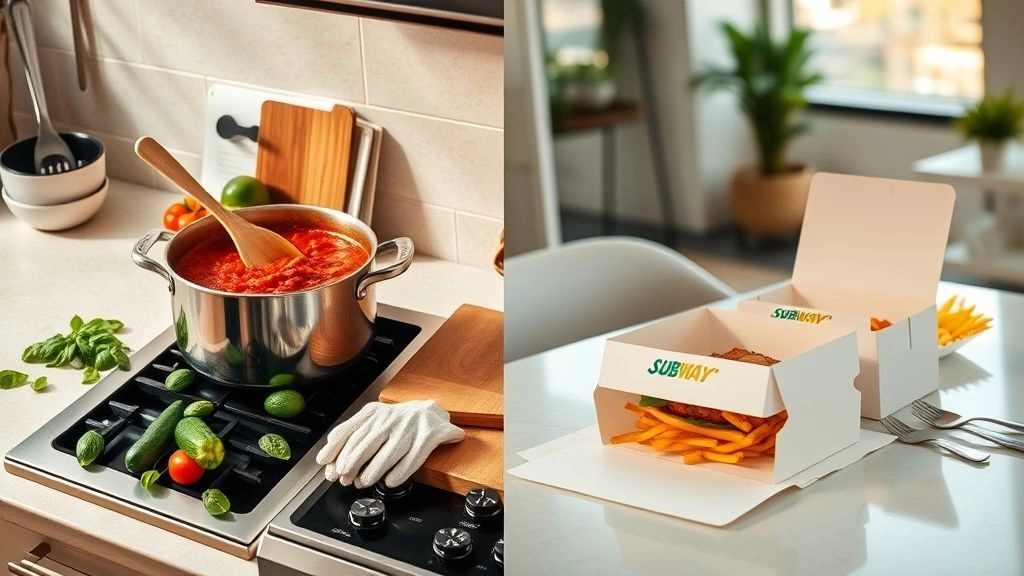Let’s cut to the chase: most of us love the convenience of eating out. It’s easy, social, and well… sometimes downright delicious. But if we’re honest, our wallets usually feel the pinch afterward. Have you ever glanced at your credit card statement and thought, “Wow, I really spent how much just on food?” Yeah, me too.
Here’s the real kicker: the average cost of eating out is around $20.37 per serving, while cooking at home averages just $4.31. That gap isn’t just pocket change; it adds up real fast over a month, a year, or a lifetime. And with prices for meals outside the home rising about 3.1% in the last 12 months compared to only a 1% increase for groceries, it’s no surprise more people are thinking twice before dining out. So, how much can cooking at home actually save you? And is it really worth trading restaurant flair for your own kitchen? Let’s dive into the numbers and a bit of soul-searching to find out.
Cost Shock
How Much Are You Really Spending?
Let’s talk hard numbers for a sec. If you eat out even just three times a week, that’s roughly $245 a month on food. Cook at home? That same amount of meals might only set you back about $50 to $65. The savings are screaming at you. Not only that, but a survey from The Harris Poll found that 83% of Americans are making saving money on food a bigger priority this year—because, well, prices keep climbing and the cost of living isn’t getting any friendlier.
I remember a friend sharing how she used to hit takeout spots nearly every other day. When she tallied up her spending, she was shocked to find she was dropping over $400 a month just on convenience. Once she tried meal prepping and cooking at home more, she easily trimmed that by two-thirds—and even had fun experimenting with recipes. (I swear, nobody becomes a kitchen wizard overnight, but those small wins feel so good.)
Of course, the numbers tell the story clearly. The Cost of eating out vs cooking at home 2025 factors in everything from groceries to the rising prices at restaurants, and the trend is obvious: home cooking wins the pocketbook every time.
Convenience vs. Budget
Yes, yes, I know what you’re thinking: “But waiting in line, parking, ordering, and the whole dining out process takes time.” But have you seriously compared that to the whole cooking routine, including grocery runs? Spoiler: if you plan meals ahead and batch cook, you save way more time than the restaurant shuffle.
Plus, with today’s grocery stores offering meal kits and prepped ingredients, plus services catering to home chefs, it’s easier than ever to whip up something tasty without spending hours in the kitchen. This thoughtful balance between saving money and convenience is helping folks regain control without feeling deprived.
Health Hits
Calories and Portions, Oh My!
Eating out sounds fun until you peek at the calorie counts. Restaurant dishes are known for extra salt, sugar, and saturated fats. Take something like a popular restaurant side dish—say, sweet potato casserole—it can pack 770 calories, while making it at home cuts that down to 500 without losing the cozy vibe.
One fun example: the classic Subway club sandwich has 530 calories and 10 grams of saturated fat when bought out, but a homemade version? Just 280 calories and barely 1.5 grams of saturated fat. Does that mean eating out is evil? Nope. But cooking at home gives you the power to control what goes into your food—and that’s a game changer for your health in the long run.
Research confirms this. Studies like those appearing in the American Journal of Preventive Medicine tell us that people who cook more at home tend to eat healthier overall without adding cost. Plus, when you cook, the portion sizes are usually just right (no accidental supersized meals here!).
If you want to geek out on the pros and cons a bit, check out this Eating out vs eating at home pros and cons guide—it breaks down every angle.
Trends and Behaviors
How Often Do We Eat Out?
You’re probably not alone if you order takeout or delivery around 4 to 5 times per month. That’s what a 2023 US Foods survey found among Americans—more than the average restaurant visits, which hover around three per month.
Why do people eat out so often? Three-quarters say they just don’t feel like cooking, 51% say convenience, and 44% enjoy the social side. The thing is, many also love the vibe and experience of dining out. But, interestingly, more than half prefer takeout over actually going into a restaurant for that same reason: couch comfort and less fuss.
This shifting dance between social life, time-saving, and budgeting has sparked a new wave where home cookers want to replicate that restaurant magic in their own kitchen without breaking the bank. Ever heard of services that bring gourmet chef meals to your door for home reheat? Yeah, that’s part of it now.
For a peek into how the gap between eating out and dining in is widening lately, see the Compare and contrast eating at home vs eating out angle.
Home Cooking: The New Dining Out?
Turns out, 46% of people say they’re cooking and eating at home more often these days, driven not just by saving money but by wanting more control and comfort amid the crazy world we live in. People want their home meals to feel like a treat, not a chore.
And restaurants have noticed. Many are branching out by offering grocery aisles stocked with their signature sauces or even meal kits you can complete at home. So rather than missing out on your favorite dishes, you get the best of both worlds—restaurant quality and home price.
Easy Budget Swaps
Small Changes, Big Savings
The idea of ditching all takeout immediately? Nah, that’s not realistic for most of us. But what if you start small? Maybe swap just one meal a week from takeout to homemade. It’s surprisingly doable and can free up dozens of dollars fast.
Batch-cooking is a lifesaver here. Pick your “cook once, eat thrice” recipes and freeze those extras. Suddenly, you have homemade meals ready to go on your busiest days—no rush, no expensive delivery fees.
One time, I tried turning my leftover roasted veggies and grilled chicken into restaurant-style taco bowls. It took zero extra money and leftovers got a second life. My family loved it, and I saved $50 that week just skipping takeout twice.
Pros and Cons Cheat Sheet
| Factor | Eating Out | Cooking At Home |
|---|---|---|
| Cost | High; ~$20+ per serving | Low; ~$4.31 per serving |
| Time | Can be long (waiting, parking) | Varies; can be quick with prep |
| Health | Often higher calories & sodium | More control, generally healthier |
| Convenience | High; no cleanup needed | Requires effort; meal prep helps |
| Experience | Social and atmospheric | Cozy, personal, customizable |
If you want to really weigh your options, this Eating at home vs eating out essay lays it out well.
Wrapping It Up
Here’s the bottom line: eating out might give you a quick fix with good vibes, but the cost difference? Huge. From $20.37 for restaurant meals to $4.31 at home, the numbers don’t lie. Plus, cooking at home usually means healthier meals and better portion control. And yes, it can be fun once you find your groove.
You don’t have to go cold turkey on dining out. Try swapping just a meal or two a week. Meal prep smart, get creative, and watch your budget breathe easier. As more people realize this, it’s shaping a new food culture: delicious, affordable, home-based meals that still feel special.
What do you think? Ready to start your own kitchen makeover? Share your wins, stumbles, or favorite budget recipes somewhere cozy. Need more inspiration? Jump into the Cost of eating out vs cooking at home 2025 and Eating out vs eating at home pros and cons guides to stay sharp and motivated.
Remember, it’s not about being perfect—it’s about making money-smart and health-wise choices that work for you. Your wallet (and maybe your waistline) will thank you.













